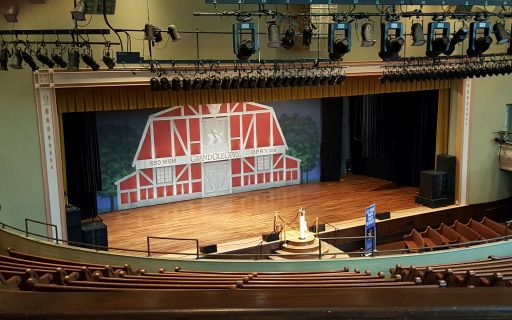Today in 1974, the last Saturday night performance of the Grand Ole Opry at Nashville’s Ryman Auditorium was held as the show moved the new Opryland. The Ryman had been home to the show since 1941.
Ryman Auditorium was included in the National Register of Historic Places in 1971 and was later designated a National Historic Landmark on June 25, 2001, for its pivotal role in the popularization of country music.
The auditorium opened as the Union Gospel Tabernacle in 1892. Its construction was spearheaded by Thomas Ryman (1843–1904), a Nashville businessman who owned several saloons and a fleet of riverboats. Ryman conceived the idea of the auditorium as a tabernacle for the influential revivalist Samuel Porter Jones. He had attended one of Jones’ 1885 tent revivals with the intent to heckle, but was instead converted into a devout Christian who pledged to build the tabernacle so the people of Nashville could attend large-scale revivals indoors. It took seven years to complete and cost $100,000 (equivalent to $2,845,556 in 2019).
After debuting in 1925, the local country music radio program known as the Grand Ole Opry (originally called the WSM Barn Dance) became a Nashville institution. Broadcast over AM radio station WSM, it could be heard in 30 states across the eastern part of the nation. Although not originally a stage show, the Opry began to attract listeners from around the region who would go to the WSM studio to see it live. When crowds got too large for the studio, WSM began broadcasting the show from the Hillsboro Theatre (now Belcourt Theatre) in 1934. The Opry moved to East Nashville’s Dixie Tabernacle in 1936 and then to War Memorial Auditorium in 1939.
After four years – and several reports of upholstery damage caused by its rowdy crowds – the Opry was asked to leave War Memorial and sought a new home yet again. Thanks to its wooden pews and central location, Ryman leaders thought the auditorium would be a perfect venue for such an audience and began renting the venue to WSM for its shows. The Grand Ole Opry was first broadcast from the Ryman on June 5, 1943, and originated there every week for nearly 31 years thereafter. Every show sold out, and hundreds of fans were often turned away.
During its tenure at Ryman Auditorium, the Opry hosted the biggest country music stars of the day and became a show known around the world. In addition to its home on WSM, portions of the show (at various times throughout its history) were also broadcast on network radio and television to a wider audience. Melding its then-current usage with the building’s origins as a house of worship, the Ryman got the nickname “The Mother Church of Country Music”, which it still holds to this day.
WSM financed minor upgrades to the Opry House in 1966 to maintain its functionality, but soon began making plans to move the Opry to a new location altogether. Despite the building’s deteriorating condition, the lack of air conditioning, and the abundance of unsavory surroundings in its urban neighborhood, the show’s increasing popularity often resulted in crowds too large to fit inside the venue. Plans announced in 1969 centered around a larger, custom-built auditorium that would provide a more controlled and comfortable atmosphere for audiences and performers alike, as well as better radio and television production facilities. The company purchased a large tract of land in a then-rural area a few miles away, and the new Opry theater served as the anchor of a grand entertainment complex. The development became known as Opryland USA and eventually included the Opryland theme park and the Opryland Hotel.
The amusement park opened on May 27, 1972, and the new venue (also called the Grand Ole Opry House) debuted on Saturday, March 16, 1974. The final shows at the Ryman were emotional. Sarah Cannon, performing as Minnie Pearl, broke character and cried on stage. In an effort to maintain continuity with the Opry’s storied past, a large circle was cut from the floor of the Ryman stage and inlaid into the center of the new Opry stage. In another traditional holdover, the new Opry House was also designed to feature pew seating, although (unlike the Ryman) they are cushioned.
Eventually and without fanfare, the building resumed using the Ryman Auditorium name to differentiate it from the new Grand Ole Opry House.
Source: Wikipedia




